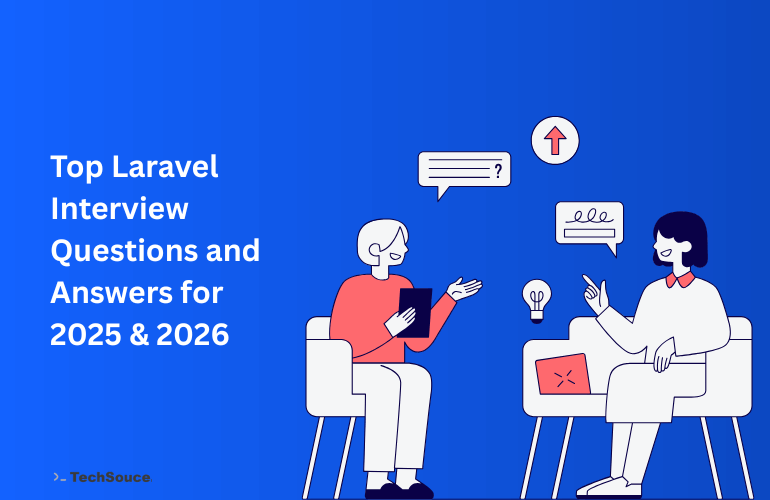Hello, Laravel developer! Feeling jittery about your interview? Relax. Grab a snack, keep your IDE open, and check out this straight-to-the-point guide. These questions have tripped up juniors and seniors alike. You will know these answers. You will ace that interview.
Introduction
Laravel keeps changing, but interview panels still love tried-and-true practical questions. Most companies use Laravel for real projects. That means they want developers who build, debug, and deploy fast. Questions now focus on Laravel 12+ features, API security, and best practices. Expect more code snippets, less theory. You want real-world answers? Here they come.
Key Interview Questions and Answers
1. What is Laravel and what’s new in Laravel 12?
Laravel is a PHP framework for web applications. Version 12 focuses on improved type safety, faster routing, and better API support. New features include route caching, native attribute casting, and simplified queue management.
2. How do you create and run migrations?
Write migration classes in /database/migrations. Use php artisan make:migration create_users_table. Run migrations with php artisan migrate. Use migrate:rollback to undo, migrate:refresh to rerun, and migrate:fresh to drop all and re-create tables
3. Explain Eloquent ORM and its advantages.
Eloquent lets you work with databases using models. You avoid raw SQL. Eloquent supports relationships, eager loading, soft deletes, and attribute casting. Your code stays clean and readable.
4. How do you implement soft deletes?
Add the SoftDeletes trait to your Eloquent model. This keeps deleted records in your database with a deleted_at timestamp. Use restore() to recover soft-deleted records later. Query for withTrashed() to list all records, including deleted ones.interviewbit
5. What are factories and seeders? Why do you use them?
Factories create fake models for testing and seeding. Seeder classes fill your tables with sample data. Use php artisan make:factory and php artisan make:seeder, then run php artisan db:seed to fill in dummy data for development or testing.
6. What is a service container?
Laravel’s service container handles dependency injection. You register classes and retrieve them anywhere in your code. This makes your app flexible and testable. The service container also resolves controllers, events, and middleware.
7. What are middleware and what’s a simple use case?
Middleware filters HTTP requests before they reach routes or controllers. Use middleware for authentication, logging, CORS, and rate limiting. To create one, run php artisan make:middleware CheckAge, then assign it in routes.
8. How do you define relationships between tables in Laravel?
Use model methods to define relationships. For example:
- One to One: hasOne, belongsTo
- One to Many: hasMany, belongsTo
- Many to Many: belongsToMany
- Polymorphic: morphTo, morphManyinterviewbit
Your Users model might have:
public function posts() { return $this->hasMany(Post::class); }
Use these relationships for cleaner code and better queries.
9. What is API throttling and how do you set it up?
Throttling limits requests to your API. Protects against abuse. Attach the throttle middleware to routes. For example, throttle:60,1 allows 60 requests per minute. Configure it in routes/api.php.
10. How do you put a Laravel application in maintenance mode?
Run php artisan down to show a friendly maintenance page. Use php artisan up to resume. Whitelist IPs to let some users view the site during maintenance.
11. What is the Blade templating engine? Why do developers like it?
Blade is Laravel’s default view engine. Write PHP directly in the .blade.php files using clean syntax. Blade supports layouts, sections, and template inheritance. You avoid messy PHP tags and write readable HTML.
12. How do you validate requests? Give an example.
Laravel validates HTTP requests using the validate() method or custom FormRequest classes. Example:
$request->validate([
'email' => 'required|email|unique:users',
'password' => 'required|min:8',
]);This saves you boilerplate and keeps controllers tidy.
13. What is a service provider and what’s its role?
Service providers bootstrap services. Every major package registers with the Laravel app container via a service provider. You write custom providers when you want to extend or replace core services.
14. How would you use queues in a real project?
Use queues for tasks like sending emails or processing uploads. Configure drivers like Redis or SQS in .env. Dispatch jobs using dispatch(). Start the worker with php artisan queue:work.
15. What are accessors and mutators in Laravel?
Accessors format database values for output, mutators format values before saving. Example:
// Mutator
public function setPasswordAttribute($value) {
$this->attributes['password'] = bcrypt($value);
}
// Accessor
public function getFullNameAttribute() {
return $this->first_name . ' ' . $this->last_name;
}Use these to automate formatting and protect sensitive data.
Practical Tips for Preparation
- Review the basics: Migrations, controllers, Blade, and Eloquent.
- Practice with the latest features of Laravel 12 and experiment with new syntax.
- Build sample apps using APIs, queues, and authentication.
- Follow Laravel’s official docs, not random forums.
- Expect code reviews and live coding tasks.
- Prepare stories for projects you worked on. Interviewers want practical experience.
- Always explain your reasoning. Bugs happen, quick fixes get you hired.
- Stay up to date with latest release notes and features.
Practice as if you are explaining your approach to another developer. Take a deep breath. You have this.
